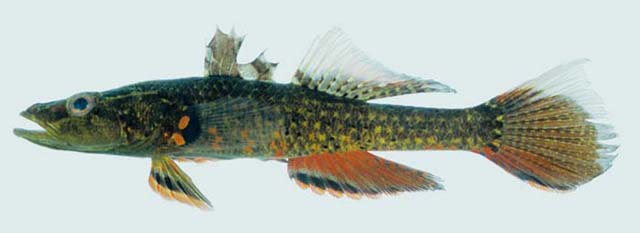| Butidae (Gudgeon gobies) |
| 14 cm SL (male/unsexed) |
|
demersal; freshwater; brackish; marine; depth range 0 - 5 m, amphidromous |
| Indo-West Pacific: Philippines and Indonesia (also Sunda Is.) through to Micronesia, southern Japan, Papua New Guinea, the Solomon Islands, Vanuatu, Fiji and New Caledonia. |
|
Dorsal spines (total): 7-7; Dorsal soft rays (total): 8-8; Anal spines: 1-1; Anal soft rays: 8-9; Vertebrae: 25-25. This species is distinguished by the followingcharacters: no scales between eyes and orbital ridges, IOS 0/1-3/0; jaws reaching back to below front part of eye; absence of auxiliary scales on body; body depth at anal fin origin 13-17% SL (Ref. 130228). |
| This species is reported to occur in many coastal streams in brackish to freshwaters and estuaries over substrates of mud, sandy mud or leaf litter and is often observed clinging upside down under dead wood, eyes facing downwards. An ambush hunter, feeding mainly on small fish and crustaceans (shrimps (Atyidae), prawns (Palaemonidae)) (Ref. 130228). .Usually found in brackish mangrove areas and in creeks and rivers, sometimes well upstream (Ref. 2847), 48637). |
|
Least Concern (LC); Date assessed: 29 June 2018 Ref. (130435)
|
| harmless |
Source and more info: www.fishbase.org. For personal, classroom, and other internal use only. Not for publication.

